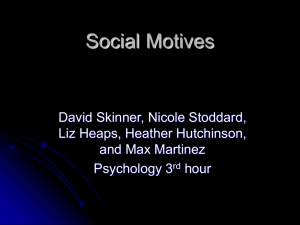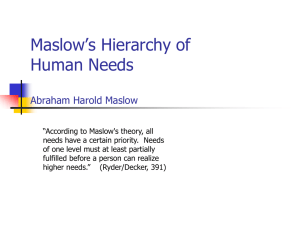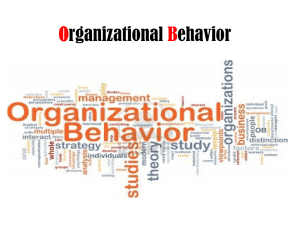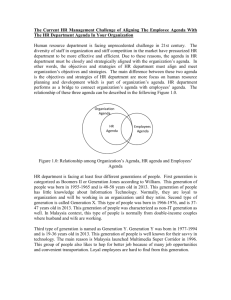File
advertisement
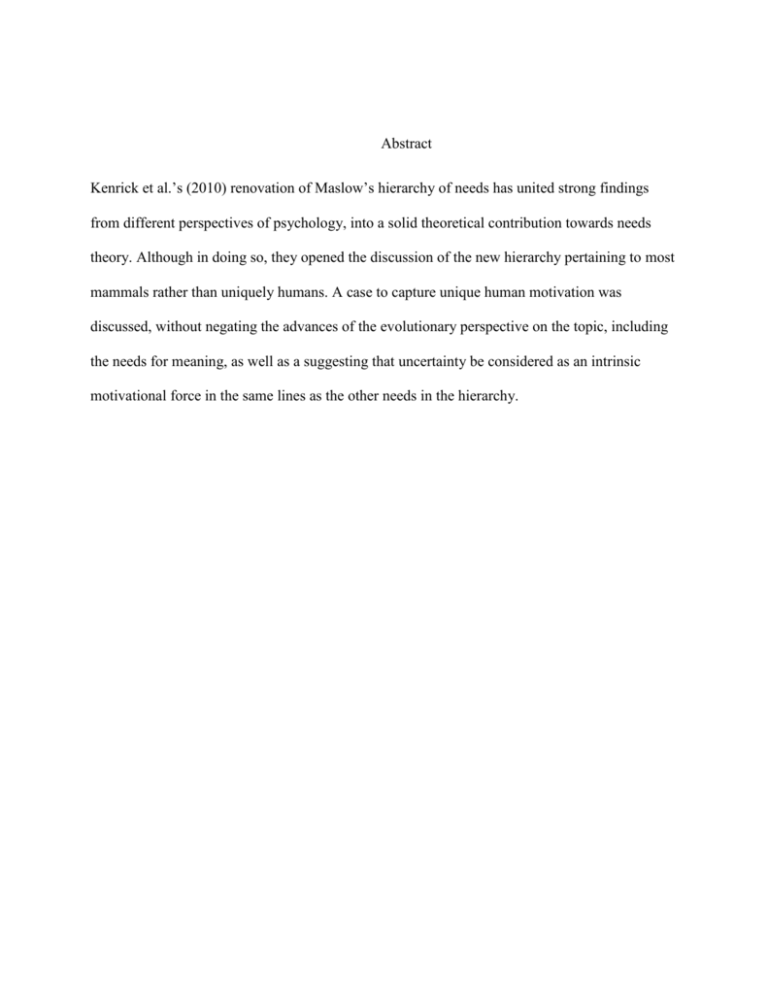
Abstract Kenrick et al.’s (2010) renovation of Maslow’s hierarchy of needs has united strong findings from different perspectives of psychology, into a solid theoretical contribution towards needs theory. Although in doing so, they opened the discussion of the new hierarchy pertaining to most mammals rather than uniquely humans. A case to capture unique human motivation was discussed, without negating the advances of the evolutionary perspective on the topic, including the needs for meaning, as well as a suggesting that uncertainty be considered as an intrinsic motivational force in the same lines as the other needs in the hierarchy. So why then do we do the things we do? Perhaps the most widely known of the content theories of motivation is Abraham Maslow’s hierarchy of needs (Uhl-Bien, Schermerhorn, & Osborn, 2014). Some of the appeal of his theory is that it provides both a theory of human motives and a theory of motivation that relates these needs to general behavior (Wahba & Bridwell, 1976). Like all content theories of motivation, Maslow’s focuses primarily on individual needs, and identifies five levels or dimensions. His concept of “hierarchy,” which contends that higher level needs, like esteem and social needs, do not become more important until lower level needs, such as physiological and safety needs, are satisfied, has received mixed support (Hall & Nougaim, 1968; Lawler & Suttle, 1972). In effect, whereas some propositions have been rejected completely, others have received mixed and questionable support at best. Furthermore, factor analyses have not shown these five dimensions of needs to be independent nor separable (Wahba & Bridyvell, 1976). Some of the reasons for the mixed results have been explained by Maslow’s chosen research methodology, his humanistic approach to psychology as well as formulating his theoretical framework from his clinical practice. Despite the lack of consistent evidence, Maslow’s model has continued to generate ideas and research on the field of psychology, including social psychology, developmental psychology, personality, and organizational behavior. In addition, his hierarchy of needs is widely cited in textbooks and there have been numerous attempts to reorganize, and improve upon his works. Most notably, Alderfer’s ERG theory (1969), in such attempt to modify and improve the model, adopted a three-level classification system and abandoned the hierarchical rigidity of his predecessor’s. However, even if it dealt with many of the deficiencies of Maslow’s model, it has generated very little empirical review as a needs theory (Dipboye, Smith & Howell, 2013). More recently, however, Kenrick et al. (2010) have used recent findings from other disciplines, particularly evolutionary psychology, to restructure Maslow’s theory in mainly three ways: at the evolutionary functional level; at the developmental level; and at the proximate inputs level. First, at the functional level of analysis, the researchers found many of Maslow ideas had good support. At the same time, they suggested that theory was faulty in grouping functionally distinct needs into single, broad dimensions. They contended that mating-related needs were better placed separately than in broader categories, and in doing so, they replaced self-actualization from the top of the hierarchy. Next, at the developmental level, the three new reproduction-focused goals of mate acquisition, mate retention and parental care, were expected to develop later in life, while other motivational systems or motives operating alongside. Finally, in terms of proximate inputs, Kenrick and colleagues concluded that the renovated pyramid must have flexibility, due to conclusive findings on goal activation (Kenrick et al., 2010). In essence, by basing human needs on solid empirical foundation of evolutionary psychology, and having united different levels of analyses by showing they complement rather than compete with each other, Kenrick et al. made a strong theoretical collaboration to needs theory. However, like Kesebir, Graham, and Oishi (2010), have pointed out, the new framework is no longer anthropocentric but animalcentric in nature (Kesebir, Graham & Oishi, 2010). They argued that Maslow purposely intended to deviate from the earlier empirically sound theories that focused on hunger and sex drives, like McDougall’s (1921) instinct theory, in that they failed to capture part of the human motivation. In that sense, a case needs to be made on what makes for a human centered needs theory. A man’s search for meaning Motivation has been described by psychologists in terms of behavioral characteristics. It has been explained in terms of acting forces within the individual that account for a certain direction, level and persistence of effort (Uhl-Bien, Schermerhorn, & Osborn, 2014). In his time, Maslow gave an explanation of what some of these forces, or motives, could be in order to understand behavior, but unlike others before him, excluding Murray (1938), he tried to capture what was really human about human beings. As such, he included and postulated the growth need of self-actualization as an uniquely human characteristic. One could argue that theories of self-actualization, including Maslow’s, may suffer from vagueness, looseness in concept, language and lack of evidence (Cofer and Apply, 1964). At the same time, recent research has revealed the need for meaning to be a possible candidate for the ultimate human need (Baumeister, 1991). In his empirically driven thesis, Baumeister (1991) makes a case in what makes a meaningful life: having a purpose, having feelings of efficacy, viewing one’s actions as having value and feeling like one has positive-self-worth. In addition, having meaning in life has been shown as a significant predictor of happiness, while loss of meaning has been linked to depression and suicide (Kesebir, Grham, Oishi, 2010). Furthermore, meaning could be found in almost any endeavor, not just adaptive systems such as mating or relationships but in occupation, leisure activities or in serving the community. It is possible that neither self-actualization nor meaning belong at the top of the hierarchy of needs proposed by Maslow, Kenrick et al, or Alderfer. Rather, they account for intrinsic forces that are not more important or less important than the others, but optional. In the same manner human beings can be impulsive and driven by instincts, human beings can also be driven to contribute beyond themselves even if there is no apparent extrinsic reward for their behavior. Such consideration, in which the needs for meaning are optional, and thus, not present in a hierarchy, makes a more compelling humanistic approach while not dismissing the multidisciplinary advances in needs theory. It is also a more flexible framework, allowing for culture variation that was not present on previous models. It is still interesting to note, however, that even Maslow began to doubt self-actualization at the top of the hierarchy. According to Koltko-Rivera (2006), Maslow began to doubt its place when he witnessed peak performance experiences in his patients. Though, he never got to publish the hierarchy revision he made in 1969, he made a case that even for those, who he considered healthy, self-actualized individuals, were motivated by something else, selftranscendence. Maslow here noted that some individuals have gone beyond even self-actualization as a salient motivation. Such individuals arrive at the top of Maslow's new hierarchy of motivation with a strong motive toward self-transcendence. That is, such individuals seek a benefit beyond the purely personal and seek communion with the transcendent, perhaps through mystical or transpersonal experiences; they come to identify with something greater than the purely individual self, often engaging in service to others (Koltko-Rivera, 2006). In this context, motives for self-transcendence and self-actualization, could be interpreted as the need to grow with the purpose of contributing beyond one self, from which meaning in life could possibly be extracted from, given that all four factors in Baumeister’s model are met, for example. Such concept could conceivably be more in line with the human condition than other models. As strong as the multi-level theoretical collaboration from Kenrick et al. is, the explanation can hardly capture the intrinsic qualities of human, not mammal, nature. A special case: the possibility of a need for uncertainty In his book, The Open and The Closed Mind (1960), Rokeach showed an impressive amount of studies that showcased differences in several domains- such as perception, religious dogma, problem solving- between open-minded people and the closed-minded. (4) The book described the open-minded as individuals with cognitive belief systems oriented towards new beliefs and information, whereas the closed-minded had belief systems that favored familiar or predictable information. Similarly, other studies have also indicated that outcome uncertainty in games led to greater enjoyment, moderated by self-efficacy and suspense. In similar fashion, as Smith, James, Varnum & Oyserman (2014) noted, college students are faced with an increasingly uncertain world, in which finding a good, fulfilling and meaningful job after they graduate, becomes more difficult each year. In spite of such uncertainty, college enrollment has not diminished. (Snyder & Dillow). In their study, they found a motivating aspect of uncertainty- in that, not knowing exactly what will happen can make a more valued outcome. Students that experienced more uncertainty about their environment, spent less hours playing games and putting in better effort, when it was coupled with self-belief that they could accomplish their goals. Based on these and similar findings, can uncertainty be an intrinsic universal need in the same lines as safety or status? And if so, where would it fit in the Maslow’s pyramid of needs? Although a more extensive research focus is warranted, a possible answer to these questions may be found in the proximity level of analysis in Kenrick et al. presented. In their argument for required theoretical flexibility regarding which motivational system is active at any given time, they discussed an assessment of trade-offs. In essence, the activation of particular motivation system, like a self-protection or safety goal in avoiding threatening situations, may entail a specific behavioral benefit as well as potential costs, as in halting consumption of caloric resources. Such system, they insist, is likely to become active as particular cues from the environment are present, (Kenrick et al., 2010). Thus, in contrast to self-protection, if a need for uncertainty were to exist, it could provide benefits in terms of stimulation, and potential costs in terms of exposing one-self to threatening situations. As a consequence of this apparent relationship to safety needs, uncertainty could be placed along the lower needs of the pyramid, rather than grouped with higher, growth needs of the hierarchy. Conclusion Uniquely human needs, like self-actualization, or the need for meaning, do not necessarily contradict findings in the field of an evolutionary perspective in psychology. In addition, meaning in life has been found as a significant predictor of happiness, and it is possible that it does not have to be more important or less important than the rest of needs in the hierarchy, but rather, it could be an uniquely human drive related to fulfillment. Even Maslow found there could be other motivations after self-actualization was achieved, thus contesting its place of importance. Furthermore, studies related to uncertainty as a motivational factor were mentioned in order to bring light to the possibility of inclusion in the hierarchy of needs. Some studies found that uncertainty, coupled with self-efficacy, could have a high degree of motivational value. If in fact, uncertainty needs could be categorized and supported, it would probably fall within the lower levels of the hierarchy. With the enduring and universally known Maslow’s framework of needs, future research should explore different exclusive human motives in order to capture what makes us do what we do. Works Cited Cofer, C. N., & Appley, M. H. (1964). Motivation: theory and research. New York: Wiley Dipboye, R. L., Smith, Carlla S. & Howell, William C. (2013). The Science and Application of Work and Organizational Psychology. Online textbook. Hall, D. T., & Nougaim, K. E. (1968). An examination of Maslow’s need hierarchy in an organizational setting. Organizational Behavior and Human Performance, 3, 12-35. Kenrick, D.T., Griskevicius, V., Neuberg, S.L., & Schaller, M. (2010). Renovating the pyramid of needs: Contemporary extensions built upon ancient foundations. Perspectives on Psychological Science, 5, 292– 314. Kesebir, S., Graham, J. & Oishi, S. (2010). A theory of human needs should be human-centered, not animal-centered: Commentary on Kenrick et al. Perspectives in Psychological Science, 5, 315-319. Lawler, E. E. III, & Suttle, J. L. (1972). A causal Correlational test of the need hierarchy concept. Organizational Behavior and Human Performance, 7, 265-287. Uhl-Bien, M., Schermerhorn, J., & Osborn, R. (2014). Organizational Behavior. 13th ed. New York: Wiley. Wahba, M. A., & Birdwell, L. G. (1976). Maslow reconsidered: A review of research on the need hierarchy theory. Organizational Behavior and Human Performance, 15, 212-240.

